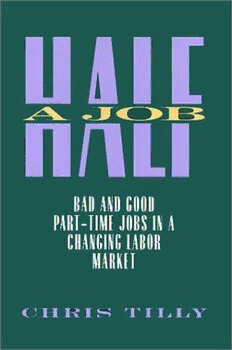
Half a Job: Bad and Good Part-Time Jobs in a Changing Labor Market PDF
Preview Half a Job: Bad and Good Part-Time Jobs in a Changing Labor Market
Half a Job Bad and Good Part-Time Jobs in a Changing Labor Market • Copyrighted Material • Copyrighted Material Job Half a Bad and Good Parl-Time Jobs in a Changing Labor Market CHRIS TILLY iii Temple University Press Philadelphia Copyrighted Material To Marie and Amanda Temple University Press, Philadelphia 19122 Copyright © 1996 by Temple University All rights reserved Published 1996 Printed in the United States of America @ The paper used in this publication meets the requirements of the American National Standard for Information Sciences Permanence of Paper for Printed Libraty Materials, ANSI Z39.48-1984 Text design by Arlene Putterman Library of Congress Cataloging-in-Publication Data Tilly, Chris. Half a job: bad and good part-time jobs in a changing labor market / Chris Tilly. p. em. Includes bibliographical references and index. ISBN 1-56639-381-7 (cloth). - ISBN 1-56639-382-5 (paper) 1. Part-time employment-United States. I. Title. HD5110.2.U5T548 1996 331.25'72-dc20 95-20654 Copyrighted Material CONTENTS LIST OF TABLES AND FIGURES Vll ACKNOWLEDGMENTS IX • 1 Half a Job Is Not Enough 1 • 2 Why Has Part-Time Employment Continued to Grow? 13 • 3 Two Theoretical Frameworks 34 • 4 Good and Bad Part-Time Jobs 47 • 5 Implications of the Distinction Between Good and Bad Pa rt-Time Jobs 70 • 6 How Businesses Set the Level of Part-Time Employment 91 • 7 Cycles and Trends 121 • 8 The Case for New Policies 158 APPENDIX: A FORMAL MODEL OF THE CYCLICAL ADJUSTMENT OF PART-TIME EMPLOYMENT IN NONCYCLICAL INDUSTRIES 189 NOTES 199 REFERENCES 207 INDEX 217 Copyrighted Material v Copyrighted Material TABLES AND FIGURES TABLES 2.1 Part-Time Employees' Family Position, Percent, 1985 16 2.2 Major Life Roles of Part-Time Workers, 1978 and 1987 16 2.3 Rate of Part-Time Employment by Age and Gender, 1969, 1979, 1989, and 1993 18 2.4 Rate of Part-Time Employment by Industry Composition, 1969, 1979, 1989, and 1993 22 2.5 Percent of Involuntary, Voluntary, and Total Part-Time Employment by Industry, 1969, 1979, 1989, and 1993 24 2.6 Percent of Involuntary, Voluntary, and Total Part-Time Employment in Boston, Pittsburgh, and the United States, 1988 29 2.7 Industry Composition of Nonagricultural Employment in Boston, Pittsburgh, and the United States, Percent, 1987 30 2.8 Types of Retail and Insurance Organizations Interviewed 31 4.1 Training Periods and Part-Time or Full-Time Status by Job at EZ Mart and SuperValu 51 4.2 Percent of Part-Time Employment by Occupation in the Retail and Grocery Industries, March 1992 67 4.3 Percent of Part-Time Employment by Occupation in the Insurance Industry, March 1992 68 5.1 Advantages and Disadvantages of Part-Time Employment for the Employer 74 5.2 Industry Composition of Part-Time and Total Workforce, 1993 89 5.3 Occupational Composition of Part-Time and Total Workforce, 1993 90 Copyrighted Material VII Vlll Tables and Figures T ABLES (continued) 5.4 Firm-Size Composition of Part-Time and Total Workforce, March 1993 90 6.1 Percent of Part-Time Employment by Major Industry, 1993 92 6.2 Percent of Part-Time Employment by Major Occupation, 1993 92 7.1 Old Versus New Measurements of Part-Time Employment, 1993 156 FIGURES 2.1 Unemployment Rates and Rates of Part-Time Employment, 1956-93 14 2.2 The Part-Time/Full-Time Hourly Wage Gap, 1973-93 20 2.3 Rate of Part-Time Employment in Retail, 1962-93 26 2.4 Rate of Part-Time Employment in Insurance, 1968-92 28 6.1 Distribution of Surveyed Retail and Insurance Firms by Rate of Part-Time Employment 94 6.2 Influences on the Department-Level Manager in Determining the Mix of Part-Time and Full-Time Jobs 106 7.1 Unemployment Rate and Rate of Involuntary Part-Time Employment, 1956-93 122 7.2 Components of the Involuntary Part-Time Workforce, 1957-93 124 7.3 Rate of Part-Time Employment in Retail and Unemployment Rate, 1962-93 127 7.4 Rate of Part-Time Employment in Insurance and Unemployment Rate, 1968-92 128 7.5 GDP Growth, Unemployment, and Involuntary Part-Time Employment, January 1991-December 1994 142 A.l Labor Market Equilibria 193 A.2 Static and Dynamic Effects of an Increase in Unemployment 195 A.3 Effects of a Decrease in Training Costs 196 A.4 Turnover Difference Schedules in Retail and Insurance Labor Markets 196 Copyrighted Material ACKNOWLEDGMENTS • IT IS TRADITIONAL TO WAIT UNTIL THE END OF THE acknowledgments for a nod to the patient spouse and family, but let me instead begin by thanking my wife, Marie Kennedy, and my stepdaugh ter, Amanda Kennedy. The two of them provided me with every con ceivable form of support as I wrote the dissertation out of which this book developed: emotional, financial, intellectual. Amanda even served as an able research assistant for data entry tasks. By the time I began to turn the dissertation into a book, Amanda had left home to pursue her own part-time jobs, but Marie continued to provide warmth, wisdom, and the occasional hard question. I dedicate this book to them. There are many other people I want to thank for their assistance on this project. First and foremost, lowe a debt of gratitude to my disserta tion committee in the departments of Economics and Urban Studies and Planning at the Massachusetts Institute of Technology: Ben Harrison, Michael Piore, and Lester Thurow. Their guidance, patience, and support made this research an enjoyable and enriching experience. Their secre taries, Meg Gross, Linda Woodbury, and Mary Lane, also helped make the process a pleasure, not least by facilitating communication with these sometimes elusive professors. For the book phase of the project, I thank Charlie Derber for spurring me to turn this work into a book, Eileen Ap pelbaum for offering a very helpful review of the manuscript, and Michael Ames, my editor at Temple University Press, for providing clear and useful advice. Others at MIT also offered their help along the way. Bob McKersie set up my initial company interviews, thereby boosting my confidence and giving me a flying start. And my "shadow" dissertation committee Copyrighted Material IX
